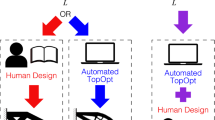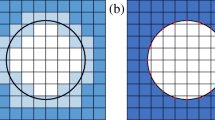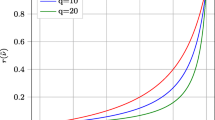Abstract
This paper provides, through both numerical analyses and physical tests, a validation of the optimality of structural designs obtained from a topology optimization process. Issues related to the manufacturability of the topology-optimized design are first addressed in order to develop structural specimens suitable for experimental validation. Multidomain and multistep topology optimization techniques are introduced that, by embedding the designer’s intuition and experience into the design process, allow for the simplification of the design layout and thus for a better manufacturability of the design. A boundary identification method is also proposed that is applied to produce a smooth boundary for the design. An STL (STereo Lithography) file is then generated and used as input to a rapid prototyping machine, and physical specimens are fabricated for the experiments. Finally, the experimental measurements are compared with the theoretical and numerical predictions. Results agree extremely well for the example problems considered, and thus the optimum designs pass both virtual and physical tests. It is also shown that the optimum design obtained from topology optimization can be independent of the material used and the dimensions assumed for the structural design problem. This important feature extends the applicability of a single optimum design to a range of different designs of various sizes, and it simplifies the prototyping and experimental validation since small, inexpensive prototypes can be utilized. This could result in significant cost savings when carrying out proof-of-concept in the product development process.
Similar content being viewed by others
References
Ambrosio L, Buttazzo G (1993) An optimal design problem with perimeter penalization. Calculus Variat Partial Differential Equations 1:55–69
Belytschko T, Xiao SP, Parimi C (2003) Topology optimization with implicit functions and regularization. Int J Numer Methods Eng 57:1177–1196
Bendsøe MP (1995) Optimization of structural topology, shape, and material. Springer, Berlin Heidelberg New York
Bendsøe MP (2003) Topology optimization: theory, methods and applications. Springer, Berlin Heidelberg New York
Bendsøe MP, Kikuchi N (1988) Generating optimal topologies in structural design using a homogenization method. Comput Methods Appl Mech Energ 71:197–24
Berke L, Khot NS (1987) Structural optimization using optimality criteria. In: Soares CAM (ed) Computer aided optimal design: structural and mechanical systems. Springer, Berlin Heidelberg New York, pp 271–311
Fleury C, Braibant V (1986) Structural optimization: a new dual method using mixed variables. Int J Numer Methods Eng 23:409–428
Guest JK, Prevost JH, Belytschko T (2004) Achieving minimum length scale in topology optimization using nodal design variables and projection functions. Int J Numer Methods Eng 61:238–254
Haber RB, Jog CS, Bendsøe MP (1996) A new approach to variabletopology shape design using a constraint on perimeter. Struct Optim 11:1–12
Hassani B, Hinton E (1999) Homogenization and structural topology optimization: theory, practice, and software. Springer, Berlin Heidelberg New York
Ma Z-D, Kikuchi N (1995a) A new method of the sequential approximate optimization. Eng Optim 25:231–253
Ma Z-D, Kikuchi N, Cheng H-C (1995b) Topological design for vibrating structures. Comput Methods Appl Mech Eng 121:259–280
Ma Z-D, Kikuchi N, Cheng H-C, Hagiwara I (1995c) Topological optimization technique for free vibration problems. ASME J Appl Mech 62:200–207
Ma Z-D, Kikuchi N, Hagiwara I (1993) Structural topology and shape optimization for a frequency response problem. Comput Mech 13(3):157–174
Ma Z-D, Kikuchi N, Pierre C, Raju B (2002) Multi-domain topology optimization for vehicle substructure design. In: Proceedings of the 2002 ASME International mechanical engineering congress and exposition, November 2002, New Orleans, LA (IMECE2002-32908), pp 1–10
Ma Z-D, Wang H, Kikuchi N, Pierre C, Raju B (2003) Substructure design using a multi-domain multi-step topology optimization. SAE J Passenger Cars Mech Syst September 2004, pp 1349–1358. Also available as SAE Paper 03B-125
Peterson J, Sigmund O (1998) Slope constraint topology optimization. Int J Numer Methods Eng 41:1417–1434
Rozvany GIN, Zhou M, Sigmund O (1994) Topology optimization in structural design. In: Adeli H (ed) Advances in design optimization. Chapman and Hall, London, pp 340–399
Sigmund O, Petersson J (1998) Numerical instabilities in topology optimization: a survey on procedures dealing with checkerboards, mesh-dependencies and local minima. Struct Optim 16:68–75
Svanberg K (1987) The method of moving asymptotes—a new method for structural optimization. Int J Numer Methods Eng 24:359–373
Wang MY, Zhou S, Ding H (2004) Nonlinear diffusions in topology optimization. Struct Multidisc Optim. DOI 10.1007/s00158-004-0436-6
Xu D, Ananthasuresh GK (2003) Freeform skeletal shape optimization of compliant mechanisms. ASME J Mech Des 125(2):253–261
Author information
Authors and Affiliations
Corresponding author
Rights and permissions
About this article
Cite this article
Ma, ZD., Wang, H., Kikuchi, N. et al. Experimental validation and prototyping of optimum designs obtained from topology optimization. Struct Multidisc Optim 31, 333–343 (2006). https://doi.org/10.1007/s00158-005-0530-4
Received:
Revised:
Published:
Issue Date:
DOI: https://doi.org/10.1007/s00158-005-0530-4




